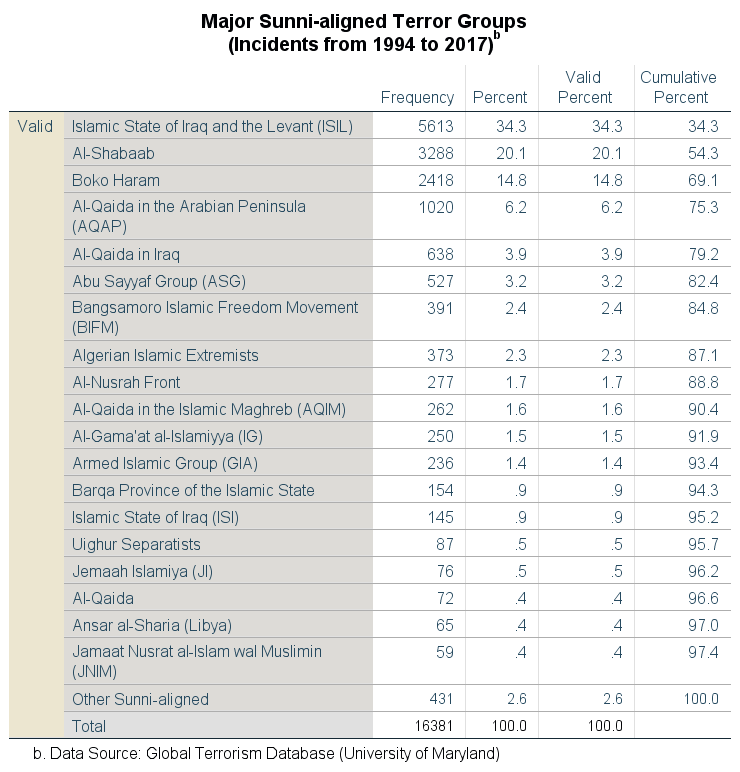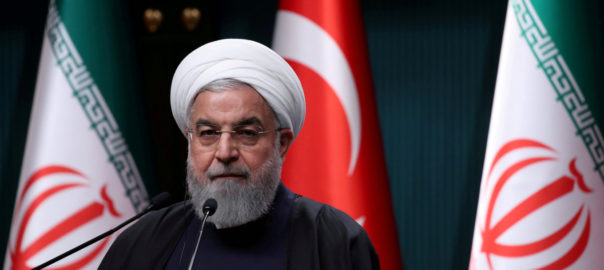By Kent R. Kroeger (NuQum.com; May 16, 2019)
In announcing the U.S. designation of the Iranian Islamic Revolutionary Guard Corps (IRGC), a branch of Iran’s armed forces, as a “terrorist organization,” U.S. Secretary of State Mike Pompeo told the State Department press corps, “This historic step will deprive the world’s leading state sponsor of terror the financial means to spread misery and death around the world.”
Coupled with the Trump administration’s ratcheting up of sanctions against Iran in early May and the recent sabotage attacks on Saudi-flagged oil tankers, the possibility of a shooting war between the U.S. and Iran has not been higher perhaps since the start of the Islamic Republic in 1979.
According to The New York Times, the Pentagon is updating its Iran war plans, similar to pre-planning associated with the 2003 Iraq War. While President Donald Trump denies such a process is ongoing, it would be consistent with standard Pentagon operating procedures anytime the heightened possibility of a U.S. military engagement exists.
But with any commitment of U.S. military personnel to combat, the administration’s justification to the U.S. public requires a consensus view that the enemy — in this case, Iran — is an unequivocal and imminent threat to U.S. national security.
That is why calling Iran the leading state sponsor of terrorism — and people believing it — is so critical. Should that accusation lack credibility, the entire War-on-Iran project is at risk.
This is why we hear the ‘Iran is the leading sponsor of terrorism’ refrain is repeated over and over again by hawkish neoconservatives, typically without any substantive push back from the news media or other politicians. Eventually, people will just assume it is true, even if Iran’s leaders insist it is not.
When asked once about Iranian denials about a nuclear weapons program, South Carolina Senator Lindsay Graham replied: “Everything I know about the Iranians I learned in the poolroom. I ran the poolroom when I was a kid and I met a lot of liars and I know the Iranians are lying.”
Graham’s Senate colleague and good friend, the late John McCain, famously insinuated he would go to war with Iran if he were elected president when he sang “bomb bomb Iran” to the melody of the Beach Boys’ old hit song “Barbara Ann.”
“Why do we keep listening to these people?” asks author Robert Morris, who as written frequently on Iran, Saudi Arabia and other Middle East topics. “Their fantasies are hurting Iran, hurting the rest of the world, and they are hurting the United States.”
Data and Methods
The easy answer to Morris’ question is that few U.S. journalists and political elites challenge the ‘Iran is the leading state sponsor of terrorism’ narrative. If they did, they might start by digging into the University of Maryland’s Global Terrorism Database (GTD), an open-source database on terrorist events around the world from 1970 through 2017.
Though the GTD does not identify state sponsors of individual terrorist acts, it does indicate — when known — the group(s) that perpetrated the act. Terrorist incidents where the perpetrators were unknown were excluded in the following analysis. From this information, I was able to segregate individual terrorist acts by the ideological alignment of the terrorist groups involved and used this as a proxy measure of state-sponsored terrorist activities.
Methodological Note: As is often the case in social science research, control the definitions and you control the conclusions. The statistical results presented in this essay use the GTD’s ‘terrorism’ definitions which match the definitions used by the U.S. government and many other Western defense and security agencies. Groups labelled in this essay as terrorist organizations (e.g., Hamas, Hezbollah, etc.) may not fit others’ definitions , including my own. But for this analytic exercise, using the U.S. government’s definitions actually serve to reinforce this study’s conclusions that common assumptions about the perpetrators of worldwide terrorism are distorted.
For worldwide terrorist acts since 1994, where the GTD identified the perpetrators (about 48 percent of all terrorist acts), I categorized the ideological orientation of the terror groups into one of four categories: (1) major Shia-aligned groups, (2) major Sunni-aligned groups, (3) AF/PK Taliban-aligned, and (4) ‘Other’ for all incidents linked to smaller Sunni-aligned jihadist groups (<50 attacks) or non-jihadist groups.
There are some notable exceptions. Hamas, for example, is largely a Sunni-aligned group reflecting the majority of Palestinians living in Gaza, but is assumed in the West to be one of Iran’s proxies in the region. In reality, according to former Israeli national security adviser Yaakov Amidror, it is the Islamic Jihad, not Hamas, that is a completely “owned and operated Iranian subsidiary.”
“(Islamic Jihad) was established by Iran, financed by Iran, and does what Iran wants it to do,” says Amidror. Nonetheless, I categorize both Hamas and Islamic Jihad as Shia(Iran)-aligned for the purposes of this essay.
The other major exception to the ‘Shia versus Sunni’ categorization rule is the Sunni-aligned Taliban — in Afghanistan and Pakistan — that was originally financed by Saudi Arabia and trained by Pakistan’s intelligence agency, Inter-Intelligence Service (ISI), during the Soviet occupation in the 1980s. However, to consider the Taliban part of a Sunni-aligned terror network is not entirely accurate as, historically, its financial, training and materiel support has come from both Saudi Arabia and Iran.
In fact, the Taliban is one of the few combatant groups in the Middle East where Iran (Shia) and Saudi Arabia (Sunni) find some common ground. For Iran, keeping the Taliban competitive in Afghanistan serves to further drain U.S. resources and energy in the region. Whereas, for Saudi Arabia, a strong Taliban serves as an anti-Shia proxy group to counter Iranian influence in Afghanistan. Therefore, I categorize the Taliban separately from the Shia- or Sunni-aligned camps.
The Results
Since 1994, three percent of terror incidents have been associated with major Shia-aligned terror groups (see terror group list in Appendix), compared to 27 percent for major Sunni-aligned terror groups (see Figure 1). The Taliban as been linked to only 15 percent of worldwide terror incidents. The vast majority of the remaining terror incidents are linked to minor Sunni-aligned jihadist groups.
Overall, the number of terrorist incidents experienced a significant increase after 2011 (the start of the Syrian Civil War) and has been dropping since 2015 when the U.S., Russia, Syria (Assad), Iraq and Iran better coordinated their efforts to rollback ISIS in Syria and Iraq.
However, Shia-aligned groups, principally the Houthi rebels, increased their activity after 2014 with the start of the Yemen Civil War. Even so, major Shia-aligned groups accounted for only 3 percent of incidents in 2017, compared to 38 percent for major Sunni-aligned groups.
Figure 1: Terrorist Attacks since 1994 by Terror Group Ideology
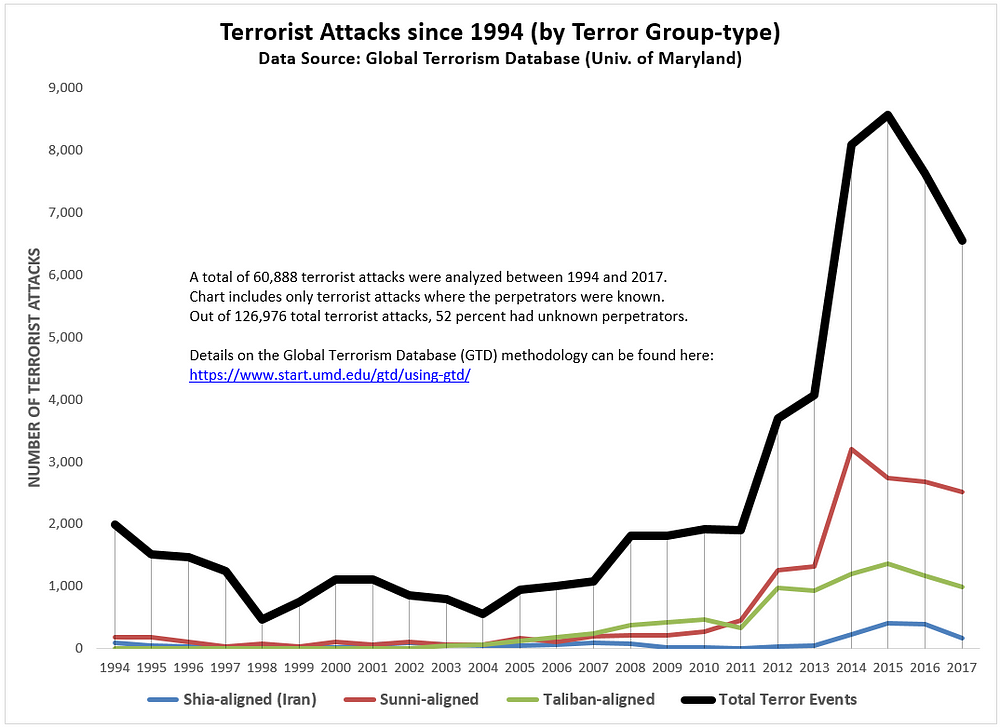
Figure 2 paints a similar picture with respect to the number of people killed in terror attacks between 1994 and 2017. Deaths linked to major Shia-aligned groups accounted for 2 percent of the 218,104 killed in terror attacks during this period. In contrast, major Sunni-aligned groups accounted for 43 percent and the Taliban 16 percent of terror deaths.
The lethality of Sunni terror attacks was also significantly higher than for either Shia- or Taliban-related attacks. Sunni attacks averaged 5.7 deaths per attack, compared to 4.0 for the Taliban and 2.4 for Shia groups. Between 2014 and 2017, the Sunni-aligned Islamic State in the Levant (ISIL) averaged 7.2 deaths per attack and alone accounted for 31 percent of all terrors deaths in that period.
Figure 2: Number Killed by Terrorist Attacks since 1994 by Terror Group Ideology

In Figure 3, we see there have been four periods of heightened activity among Shia-aligned terror attacks between 1994 and 2017: (a) the end of the First Palestinian Intifada (1994), (b) the peak of the Second Palestinian Intifada (2001 to 2003), (c) the 2006 Israeli-Hezbollah War and (d) the still ongoing Yemen Civil War from 2014 to 2017.
Among those spikes in terror activity, the Yemen Civil War has witnessed by far the biggest increases in Shia-related activity, sourced almost exclusively from the Houthi rebels (Ansar Allah). Between 2014 and 2017, the Houthis were responsible for 1,027 terror attacks (87% of all Shia-aligned attacks) compared to 8 percent for Hamas and less than 2 percent for Hezbollah.
Figure 3: Terrorist Attacks since 1994 by Shia-aligned Groups

But the Shia numbers pale in size relative to Sunni-related terror activity in that same period (see Figure 4). Between 2014 and 2017, ISIL alone was responsible for 5,329 attacks and Boko Haram and al Shabaab, combined, added another 4,010 attacks to the Sunni-aligned total.
Figure 4: Terrorist Attacks since 1994 by Sunni-aligned Groups
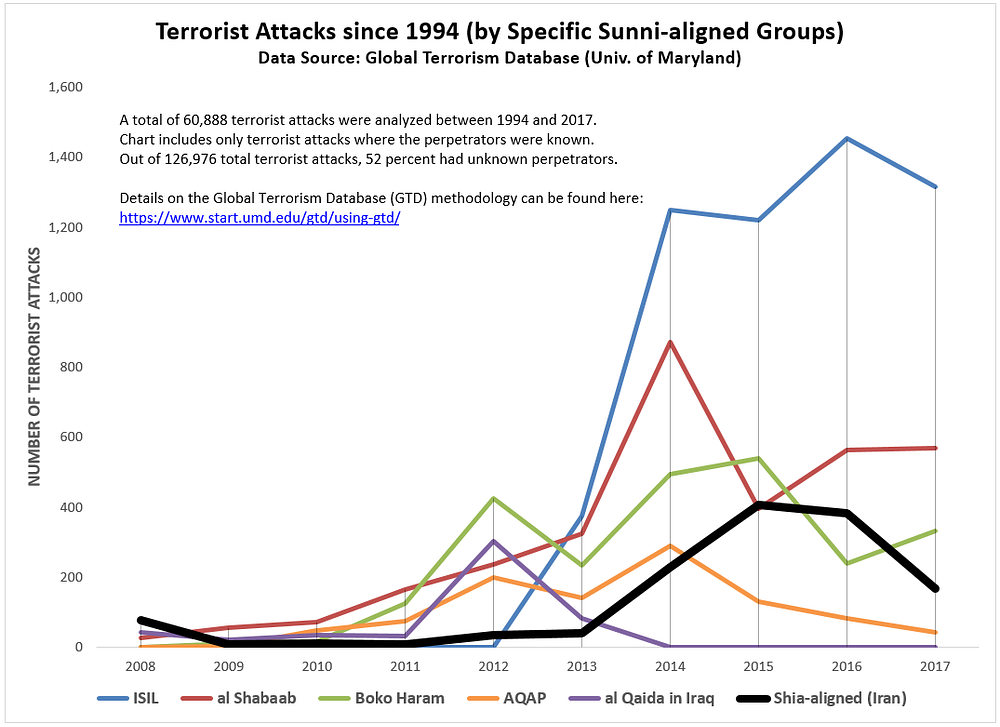
Shia-aligned terror groups are just not in the same league as the major Sunni-aligned groups — which U.S. and Western intelligence services acknowledge receive significant financial and materiel support from state and non-state actors in Saudi Arabia, the United Arab Emirates (UAE) and other Sunni-majority countries.
This gap in Sunni versus Shia terror activity should not surprise anyone. The combined size of the Saudi and UAE economies are over 2.5 times larger than Iran’s, who additionally finds itself facing strict U.S. sanctions on its oil exports — the largest segment of Iran’s economy — which will only further degrade Iran’s ability to project power in the region.
In this context, the distorted U.S. propagandized image of Iran’s aggression looming over the Middle East is, frankly, ‘fake news.’ It is not happening now. And it hasn’t happened in the past — certainly not the recent past.
Using an index I’ve created called the Iran Aggression Index — which is merely the variation in Shia-aligned terrorist activity not explained by variation in Sunni-aligned terrorist activity — Figure 5 shows when Shia-aligned terrorist activity has been most aggressive. Similar to the findings in Figure 3 (above), there are four distinct periods where Shia-aligned terror activity has been higher than expected. And, again, it is the period at the start of the Yemen Civil War and leading up to the U.S. and its allies signing the Joint Comprehensive Plan of Action (JCPOA) with Iran in 2015 that Shia-related terrorist activities spiked. Whether this was done by Iran for leverage in the JCPOA negotiations is debatable, but the coincidence is nonetheless noted.
More interesting, however, is the significant decline in the Iran Aggression Index in the years immediately after Barack Obama was elected president and when the U.S. was pushing for hard for an agreement to end (or, more accurately, delay) Iran’s nuclear ambitions.
Ironically, since Trump’s election, Shia-related terrorist activities have again started to drop below baseline levels (at least in 2017).
Figure 5: Iran Aggression Index (1994 to 2017)

Final Thoughts
Iran is not by any stretch of the imagination the largest state-sponsor of terrorism, regardless of how one wants to define and divide up terrorist activities over the past 25 years.
Between Iran’s known sponsorship of terrorist acts — and, make no mistake, Iran has sponsored heinous terrorist acts, most notably the 1983 Beirut barracks bombings killing 305 U.S. and French military personnel — and Saudi Arabia’s known complicity in financing ISIS and other Sunni-aligned terrorist activities, there is plenty of complicity in worldwide terrorism to spread around at the state-level.
Israel is now known to have helped finance and arm ISIS in its fight against the Assad regime. “The enemy of my enemy is my friend,” says the ancient proverb. Statecraft is a ruthless business.
The U.S. itself armed known elements of jihadist terror groups — such as the Al-Nusrah Front — during the Syrian Civil War. From 2012, after the U.S. had started arming ‘moderate’ factions of the Al-Nusrah Front, this group committed 277 known terrorist attacks, killing 2,978 people, many of them civilians.
But since it was in the service of fighting Syria’s Bashar al Assad, a man that gassed his own people, doesn’t that make it OK? For the hundreds of thousands of Syrian civilians killed by the Iran-backed Assad regime, ISIS and other various rebel groups roaming Syria during the civil war, assigning original blame is not much help. But I hope we can agree that arming known terrorist groups in an attempt to overthrow a vicious dictator is formula for deadly, unintended consequences.
Iran will never be the dominant hegemon in the Middle East. There are simply not enough Shia Muslims upon which to build such dominance. An Iran with nuclear weapons, on the other hand, would be a major threat to states like Israel and Saudi Arabia and it is not all surprising (and is entirely defensible) that such countries would do everything in their power to stop that from becoming a reality.
Iran must not have nuclear weapons (neither should Israel, India or Pakistan, for that matter).
But Iran is not the leading state-sponsor of terrorism in the world and predicating another U.S.-led land war in the Middle East on such a fiction will only fuel worldwide opposition to such a war. And wars built on lies don’t generally end well for the U.S.
- K.R.K.
APPENDIX: List of Major Terror Groups
Major Shia-aligned Terror Groups:
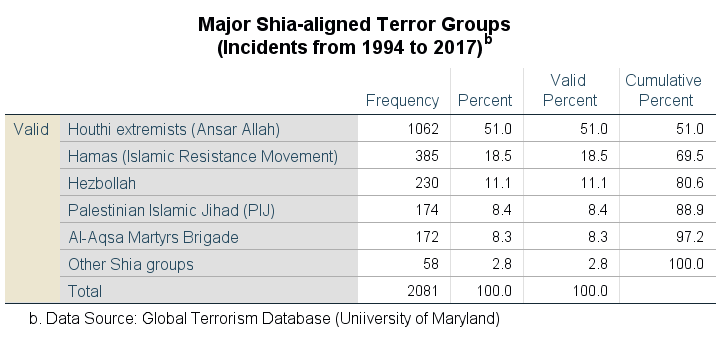
Major Sunni-aligned Terror Groups:
